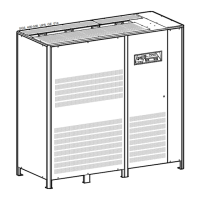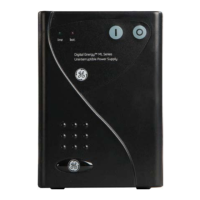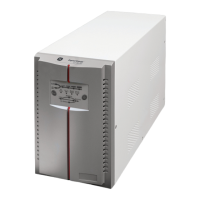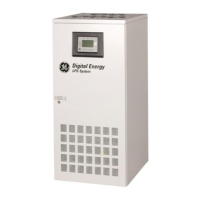Modifications reserved Pagina 64/90
OPM_SPE_XXX_60K_60K_7GB_V010.doc Operatine Manual SitePro 60 kVA
8.1.1 Initial start-up
NOTE !
Before proceeding to turn on the UPS system, ensure that the AC and DC external
isolators are OFF, and prevent their inadverted operation.
Ensure that the output load distribution can be powered and all the output
isolators are open.
Open the front door and make sure that:
a) All the connections to the input/output terminals of the UPS have been made correctly.
b) The safety screens are fixed in their position.
c) The switches Q1, Q2 and Q4 are OFF (0) and the external battery circuit breaker or battery fuses
are open.
FOR THE SINGLE VERSION PERFORM THE FOLLOWING OPERATIONS
1. Switch-ON the mains voltage from the input distribution (both rectifier and bypass if separated).
At this stage the electronic power supply is switched ON and the buzzer sounds.
LED 2 must be ON.
The control panel must be lit, and the LED “service check” is ON.
On the LCD panel you can see that the auto-test procedure is running.
If the test results OK, “SELF TEST OK” will appear on the display.
The main screen will indicate the status “load off”.
Verify/set the real clock time (refer to Section 7.3 - Parameters).
2. Check for correct phase rotation of input mains on ”P1 - Power Interface”.
• Lamp B1 ON: the phase rotation (clockwise) is correct (see Fig. 4.8.2-1).
• Lamp B1 OFF: the phase rotation (anti-clockwise) is not correct (see Fig. 4.8.2-1).
In this case switch OFF the mains, reverse two phases between them on the
line supplying the UPS and repeat the procedure from point 1.
LED 2 on the control panel must be lit.
3. Close the input switch Q4.
LED 1 must be lit and LED 3 (inside rectifier symbol) must blink.
The rectifier starts up automatically, supplying the DC circuit, and charging the DC capacitors.
After some seconds, the contactor K3 closes (the green LED 1 - K3 ON on “P1 - Power Interface” lights
up, see Fig. 4.8.2-1).
The LED 3 (inside rectifier symbol) stops blinking and stays ON, indicating that the DC link has
reached the floating voltage.
4. Battery coupling to DC link.
Close the external battery circuit breaker or battery fuses, after checking the right polarity.
The battery is now connected to the DC link.
LED 4b should be lit indicating battery charge.
The buzzer switch OFF and LED “alarm” is OFF.
Continue
►
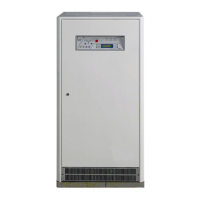
